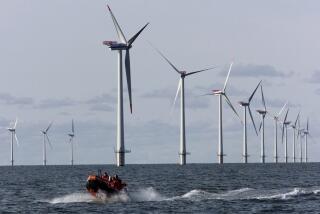Obama energy plan may be losing steam
- Share via
WASHINGTON — Barack Obama portrays his stimulus plan as a quick jolt for the ailing economy and a “down payment” on his priorities as president. But those goals appear to be colliding in at least one key area: energy independence.
The stimulus package increasingly appears unlikely to include major investments in “green infrastructure” -- the wires and rails that could deliver renewable energy to Americans’ homes and help end the nation’s addiction to oil -- according to alternative-energy advocates who are discussing the plans with the Obama transition team.
It’s a timing issue. The blueprints and, in many cases, the authority don’t exist to lay miles of high-speed rail lines or to build a sprawling web of power lines to create a truly national electric grid.
“Before you spend billions of dollars on new lines, you have to spend millions of dollars on design work,” said Michael Moynihan, the green project director of the liberal think tank NDN in Washington, who has worked extensively on green infrastructure and the stimulus. “Nobody had been thinking about this much money [becoming available]. So the planning just has not been done.”
Obama spokeswoman Amy Brundage stressed the president-elect’s commitment to green infrastructure earlier this week but did not disclose details.
“President-elect Obama is committed to making sure we are moving forward with smart-grid projects and mass transit initiatives that will spur long-term growth in our economy,” she said. Smart-grid technology includes, for example, metering systems that help consumers use less energy.
“Clean energy and infrastructure are top priorities in an American Recovery and Reinvestment plan,” Brundage said, “and President-elect Obama’s team is working to make these essential investments to create jobs and help put our economy back on track.”
The U.S. now uses a series of regional power grids that make it impossible for a wind farm in Texas to send electricity to a skyscraper in New York. Advocates say that could change under a vastly expanded national grid, opening markets for wind, solar and other energy alternatives.
Obama has pledged to invest in green infrastructure as part of his push to reduce America’s dependence on foreign oil. At a Senate confirmation hearing Tuesday, Obama’s Energy secretary nominee, Nobel Prize-winning physicist Steven Chu, said a nationwide grid would be “in the national interest” and said the country needed a “new way of doing business” to get it built quickly.
Chu also acknowledged the biggest obstacle: determining where to put those power lines. States, municipalities and landowners have protested plans to string transmission networks through their backyards. At Chu’s confirmation hearing, Sen. Robert Menendez (D-N.J.) pushed the nominee to consider reducing the amount of New Jersey land currently tagged as a possible transmission corridor.
Those questions probably mean that any major grid expansion would take longer -- and need to clear more hurdles -- than the Obama team would like for a stimulus plan focused on immediacy.
“Getting approval to build renewable-energy transmission to bring wind and solar to market from remote areas is something where states have an interest and landowners have an interest,” said Reid Detchon, executive director of the Energy Future Coalition in Washington, who has pushed for grid upgrades in the stimulus plan. “You’re not going to see big transmission towers going up overnight.”
Advocates haven’t given up on major green infrastructure investments from Congress even if they don’t make the stimulus package. Grid expansion -- and regulations easing its way -- could wind up in a comprehensive energy bill this year. Transit spending could be a large piece of a new transportation bill this fall.
In the stimulus plan, Moynihan is pushing for a $50-billion to $100-billion fund to allow “time-released” spending on unspecified green projects over the next couple of years. Other environmental groups are working to focus transportation spending on repairing existing roads, not building new ones to encourage more gas guzzling.
Several environmentalists say they expect the stimulus package to include up to $2 billion for smart-grid technology. That’s a small percentage of the $700-billion-plus stimulus plan. But just a few months ago, environmentalists note, $2 billion sounded like a lot of money.
--
More to Read
Sign up for Essential California
The most important California stories and recommendations in your inbox every morning.
You may occasionally receive promotional content from the Los Angeles Times.













